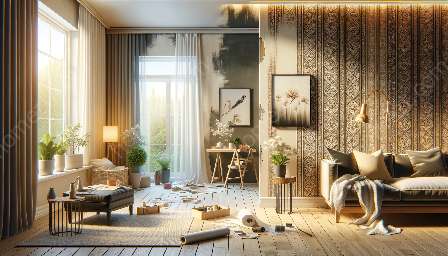When it comes to homemaking and interior decor, the finishing touches on your walls can make a significant impact on the overall look and feel of a room. Wall painting and wallpapering are commonly used to transform the appearance of a space, and understanding the different wall finishes and sheen levels is crucial in achieving the desired aesthetic. In this comprehensive guide, we will delve into the world of wall finishes and sheen levels, exploring how they complement wall painting, wallpapering, and interior decor.
Types of Wall Finishes
Wall finishes refer to the materials and techniques used to create the final surface of interior walls. Each type of wall finish offers unique aesthetic and functional characteristics that can enhance the visual appeal of a room.
1. Paint Finishes
Paint is one of the most popular choices for wall finishes. It is available in a wide range of colors and textures, allowing homeowners to customize the look of their walls to suit their preferences. Common types of paint finishes include:
- Flat or Matte: This finish has a non-reflective and velvety appearance, making it ideal for concealing imperfections on the walls. It provides a subtle and elegant look to the room.
- Eggshell: With a slight sheen, eggshell finish offers a delicate balance between hiding wall imperfections and providing a washable surface. It is a versatile option for various spaces in the home.
- Satin: This finish has a gentle sheen that adds a touch of warmth to the walls. It is easy to clean and is suitable for high-traffic areas.
- Semi-Gloss: Semi-gloss finish has a noticeable reflective quality, making it highly durable and resistant to moisture. It is often used in kitchens, bathrooms, and trim work.
2. Textured Wall Finishes
Textured wall finishes, such as stucco, Venetian plaster, and faux finishes, add depth and dimension to the walls. They are designed to create visual interest and can be used to cover flaws or create a specific ambiance in a room. Texture can be achieved through various application techniques, offering endless design possibilities.
3. Wallpaper Finishes
Wallpaper is a versatile alternative to paint, offering an extensive array of designs, patterns, and textures. From traditional to modern styles, wallpaper finishes can transform the look of a space dramatically. Some common types of wallpaper finishes include:
- Embossed: This finish features raised patterns that add a tactile element to the walls, creating a luxurious and intricate appearance.
- Textured: Textured wallpaper adds depth and visual interest, simulating a variety of materials such as grasscloth, linen, or suede.
- Vinyl: Vinyl wallpaper finishes offer durability and washability, making them suitable for high-traffic areas and moisture-prone spaces.
Exploring Sheen Levels
Sheen levels, also known as paint finishes, refer to the amount of light reflected by the painted or wallpapered surface. The choice of sheen level can significantly affect the appearance and functionality of the walls.
The most common sheen levels for wall finishes and wallpaper include:
- Flat: This sheen level has a non-reflective and velvety appearance, providing a smooth and subtle finish. It is ideal for concealing imperfections but may be less washable than higher sheen levels.
- Eggshell: Eggshell sheen offers a soft, subtle shine that is easy to clean and maintain. It strikes a balance between hiding imperfections and providing a washable surface, making it versatile for various spaces.
- Satin: Satin sheen provides a gentle reflective quality, adding warmth and depth to the walls. It is durable and washable, suitable for moderate to high-traffic areas.
- Glossy: Glossy sheen reflects light and offers a high level of durability and washability. It is commonly used in areas that require frequent cleaning or where a dramatic effect is desired.
Impact on Interior Decor
Wall finishes and sheen levels play a crucial role in enhancing interior decor. The choice of finish can create different atmospheres and visually transform the perception of space. For example, using textured finishes can add richness and depth to a room, while high-gloss finishes can contribute to a modern and sophisticated aesthetic.
The relationship between wall finishes, sheen levels, wall painting, and wallpapering is intertwined, as each element contributes to the overall design concept. When selecting wall finishes and sheen levels, it is essential to consider factors such as the intended ambiance, lighting conditions, and the functional requirements of the space.
Integrating Wall Finishes and Sheen Levels into Homemaking
The integration of wall finishes and sheen levels in homemaking involves careful consideration of the desired atmosphere and practicality in living spaces. As homeowners strive to create environments that reflect their personal style, the selection of wall finishes and sheen levels becomes a defining factor in achieving the desired interior decor.
Whether opting for subtle matte finishes to create a serene ambiance or selecting high-gloss sheen levels to infuse energy into a space, homemakers can utilize the diverse options available to bring their vision to life. Furthermore, the compatibility of wall finishes and sheen levels with the overall design scheme of the home influences the coherence and harmony of the living environment.
Conclusion
Understanding the intricacies of wall finishes and sheen levels enhances the ability to make informed decisions in wall painting, wallpapering, and interior decor. By exploring the diverse types of wall finishes and their impact on interior spaces, homeowners can leverage the aesthetic and functional potential of these elements to create personalized and inviting living environments. The careful selection of wall finishes and sheen levels contributes to the cohesive and harmonious integration of design elements, ultimately enriching the homemaking experience.


